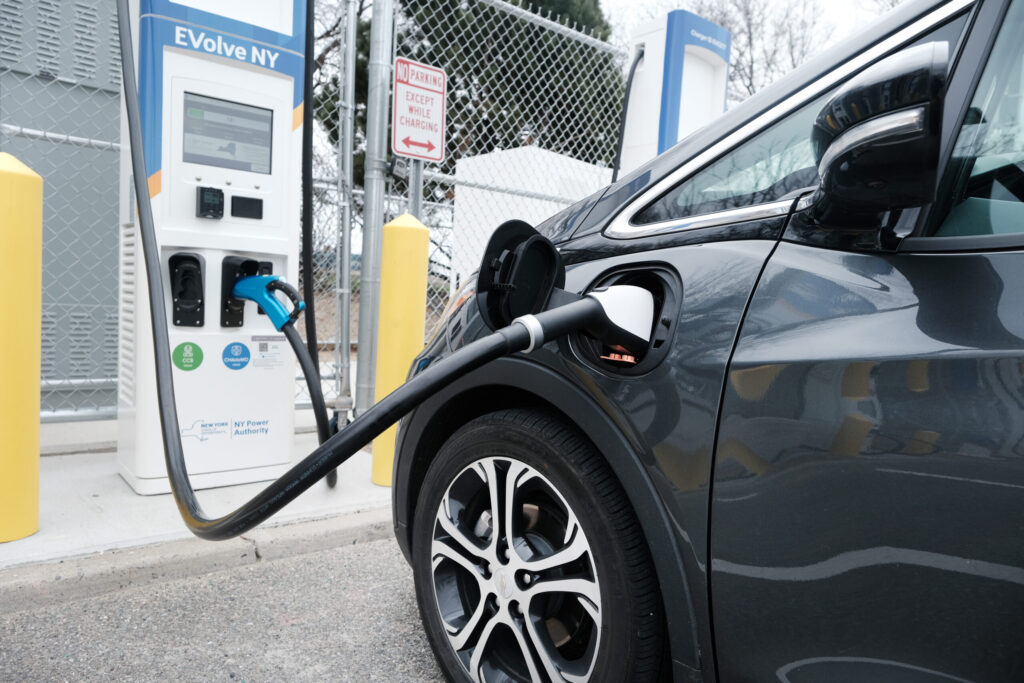More electric vehicle charging stations could become available in South Carolina in 2025, according to the state Department of Transportation. (Photo by Spencer Platt/Getty Images)
COLUMBIA — While South Carolina has set out to become a manufacturing hub for the electric vehicle industry, it continues to lag behind much of the country in availability of charging stations for drivers of the battery powered cars.
But more chargers are expected in 2025.
The Palmetto State has received $40.2 million to date in federal funding meant to boost the number of fast-charging stations along the nation’s interstate system, enabling coast-to-coast travel. An additional $30 million is still to come over the next two years.
S.C. Department of Transportation has made plans and gathered public input, both online and at in-person community forums, asking drivers where they would like to see more chargers and what amenities they would like included with these locations.
“These are essentially to facilitate long-distance travel,” said Justin Robbins, who works with the engineering firm contracted by the state to develop its plan. “They’re intended to get people on their way, so they have the ability to charge a vehicle fairly quickly. We’re working right now to figure out the optimal placement of that kind of charger.”
The agency told the SC Daily Gazette it will begin seeking contractors to build the stations by the end of this year. It expects to have chargers installed and put into service in 2025. However, a manufacturing shortage of chargers that meet federal guidelines could impact that schedule.
The state also is trying to be strategic, Robbins said, as any money left over after the fast-charging stations are built can be used at the community level to serve other places — rural areas with fewer chargers or cities without interstate access.
Meanwhile, South Carolina remains 40th in the nation and next to last in the Southeast when it comes to the number of fast chargers per capita, according to the most recent report issued by the Southern Alliance for Clean Energy. The state also trails in the number of electric vehicles sold.
South Carolina has 1,600 public charging ports at just over 600 locations, according to the U.S. Joint Office of Energy and Transportation, compared to 10,500 in Florida, 5,435 in Georgia and 4,575 in North Carolina. In the Southeast, only Alabama has fewer ports — 1,043.
It’s a problem that the Biden Administration has hoped to rectify, pumping $4.2 billion into the effort nationwide. The goal of the program, known as the National Electric Vehicle Infrastructure plan, is to have public charging stations every 50 miles along designated interstates.
In South Carolina, that includes 1-26, I-20, I-77, I-85 and I-95.
The state doesn’t meet that 50-mile standard across much of the Midlands and Lowcountry. According to state roads officials, I-85 and I-77 have adequate charging.
Only near Spartanburg and Columbia will drivers find enough stations along I-26. It’s behind in the Charleston area.
And I-95 does not meet the mark for much of its length statewide.
The lack of chargers had concerned drivers of electric vehicles and those considering purchasing one dialing in to a virtual meeting hosted by the state Transportation Department last week. Many wanted to see charging stations located near amenities such as public restrooms. And several raised concerns about charging in the Myrtle Beach area where there is no interstate.
Across the country, 33 states have already started seeking bids from contractors to build stations under the federal program. Construction is already underway in 16 of those states. And at least three already have operational stations, according to the federal agency charged with monitoring progress.
South Carolina is among seven states in the eastern half of the country not to have started the process. Much of the northwest also has yet to begin.
The post SC lags in electric car charging but more public stations are expected come 2025 appeared first on SC Daily Gazette.

